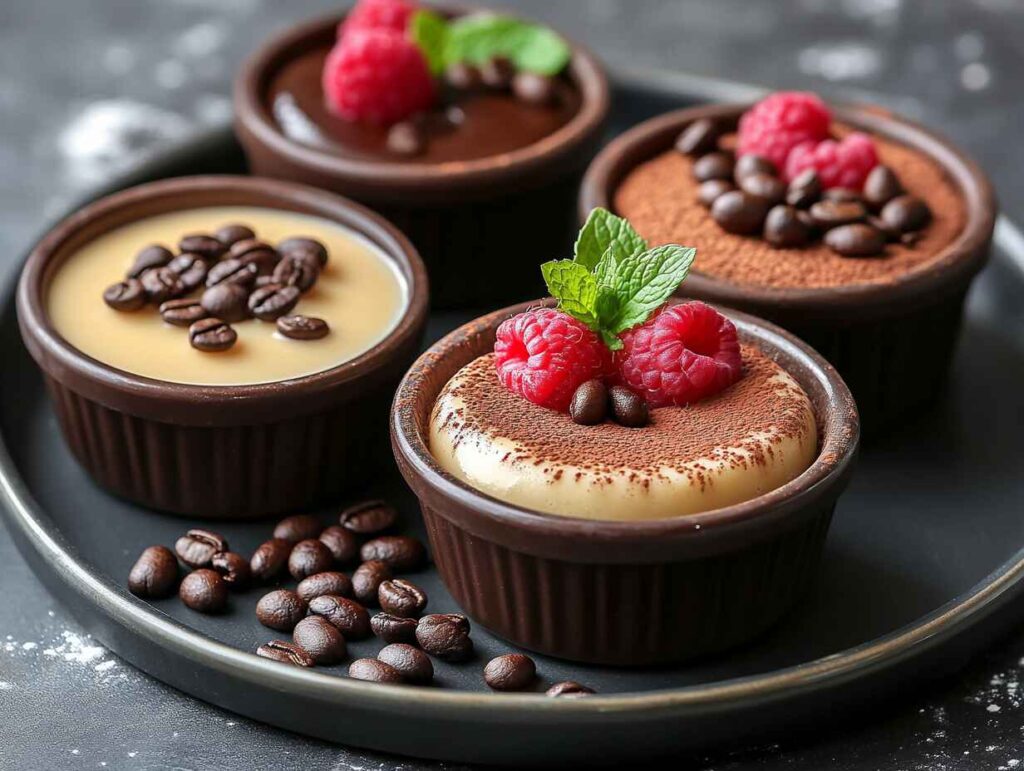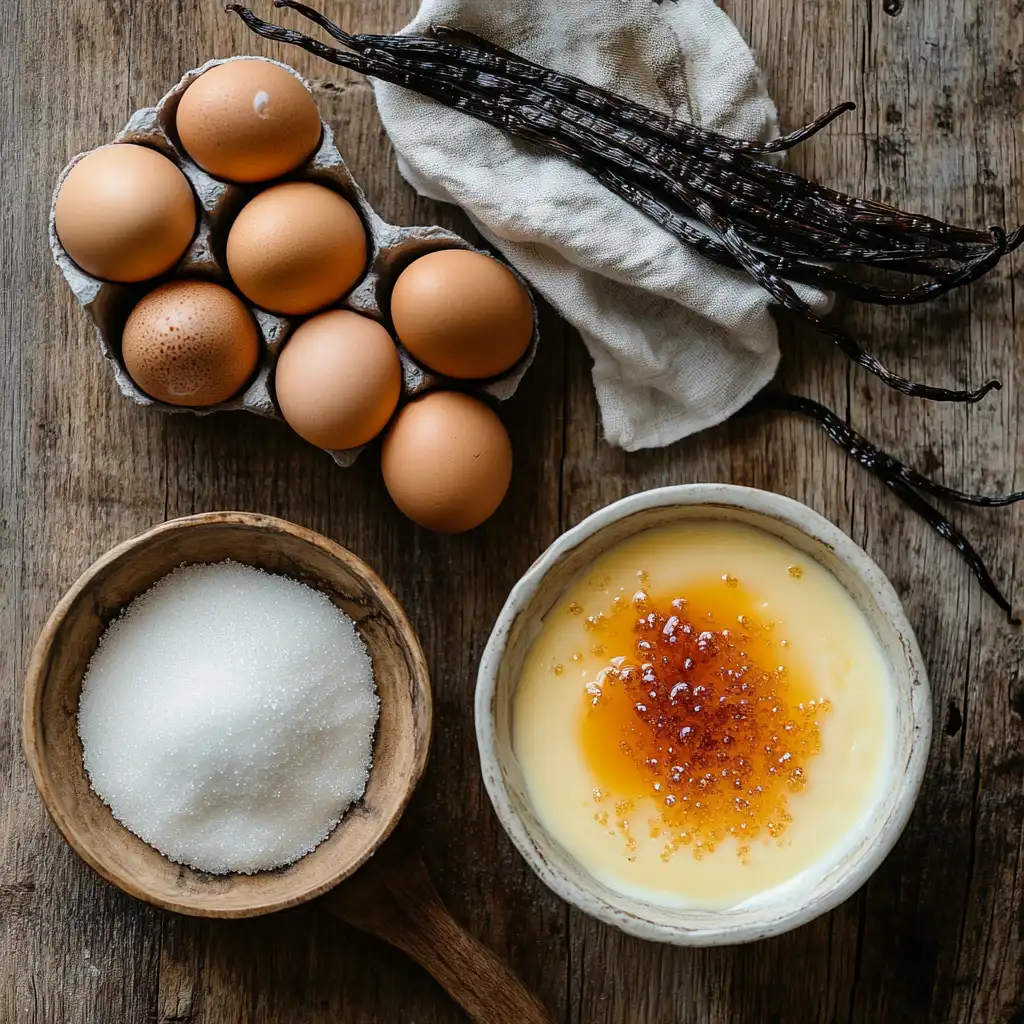What is crème brûlée made of ? Crème brûlée is a beloved French dessert known for its smooth, creamy texture and crisp caramelized sugar topping. But what is it made of, and why is it so popular? The name “crème brûlée” means “burnt cream” in French and is a symbol of elegance and indulgence in the world of desserts. This treat is cherished for its simple yet essential ingredients.
At its heart, crème brûlée is made with just a few basics: cream, sugar, egg yolks, and vanilla. These come together to form a rich, silky custard topped with a thin layer of caramelized sugar that adds a delightful crunch and sweetness.
Understanding the ingredients and techniques of crème brûlée can inspire even beginner bakers to try making it. In this article, we’ll look at what goes into this dessert, its history, how to prepare it, and tips for making it perfectly at home.
Table of Contents
The Essence of Crème Brûlée
What is Crème Brûlée?
Crème brûlée is a dessert made of creamy custard topped with caramelized sugar. The texture combines smooth, rich custard with a crisp, golden sugar crust. This mix of soft and crunchy makes it a favorite for dessert lovers. For tips on achieving the perfect caramelized crust, refer to how to caramelize crème brûlée.
To prepare it, you bake the custard slowly in a water bath. This step ensures even cooking and prevents curdling. The sugar topping is caramelized with a blowtorch or broiler, creating the dessert’s signature glassy surface. Wondering about the flavor profile? Check out what crème brûlée tastes like.
Origins and History of Crème Brûlée
The origins of crème brûlée remain a topic of debate, as France, England, and Spain each claim to have created this iconic dessert. In France, François Massialot, a chef who served royalty, popularized the recipe through his 1691 cookbook. For a unique take on crème brûlée, explore the creative crab brûlée recipe.
England offers its version, called “burnt cream” or “Trinity cream,” which became famous at Trinity College, Cambridge. Spain also contributed with crema catalana, a similar dessert featuring cinnamon and citrus flavors.
Today, you’ll find crème brûlée on menus in high-end restaurants worldwide. Its lasting popularity comes from its simplicity and elegance, paired with the skill needed to get the perfect balance of flavor and texture.
Key Ingredients of Crème Brûlée
Cream: The Velvety Base
At the heart of crème brûlée lies its luxurious custard base, made primarily with heavy cream. The cream is responsible for the dessert’s rich, silky texture, giving it a decadence that sets it apart. Curious about similar custard-based treats? Learn more about the difference between crème brûlée and custard.
While cream forms the foundation, it can be combined with milk to lighten the texture slightly. However, purists often insist on using full cream to retain the dessert’s hallmark richness. Properly heating the cream is critical, as it must be warm enough to blend with the egg yolks without cooking them prematurely.
Sugar: Sweetness with a Twist
Sugar serves two important roles in crème brûlée. First, it sweetens the custard, balancing the richness of the cream and egg yolks. Second, sugar is the key to creating the dessert’s signature caramelized topping. Granulated sugar is most commonly used for the custard, while superfine or caster sugar is preferred for the topping due to its ability to melt and caramelize evenly.
Caramelizing the sugar is a defining step in making crème brûlée. This involves sprinkling an even layer of sugar on the chilled custard and exposing it to high heat, either with a blowtorch or under a broiler, until it melts and hardens into a glass-like crust.
Egg Yolks: The Secret to Its Custard Texture
Egg yolks are the binding agent in crème brûlée, giving it its smooth and creamy custard consistency. Their natural richness complements the cream, while their proteins help thicken the mixture as it cooks. Most recipes call for several egg yolks, which must be carefully whisked with sugar until they achieve a pale, frothy texture.
The process of tempering the yolks is crucial. Warm cream is slowly added to the yolks to prevent curdling, ensuring the custard is silky and uniform. Overcooking the custard can result in a grainy texture, so precise control during the cooking process is essential.
Vanilla: The Aromatic Backbone of Crème Brûlée
Vanilla adds a classic flavor to crème brûlée, delivering a subtle yet unmistakable aromatic sweetness. Chefs typically scrape vanilla bean seeds into the cream, allowing them to infuse the custard with a deep, natural flavor. They also simmer the emptied vanilla pod in the cream to extract its essence fully.
You can substitute vanilla extract or vanilla paste, but these alternatives often lack the depth and visual appeal of the tiny black specks from fresh vanilla beans. Many chefs recommend choosing high-quality vanilla to enhance the dessert’s flavor profile.
The Art of Making Crème Brûlée
Preparing the Custard
The foundation of crème brûlée lies in its custard, a harmonious blend of cream, egg yolks, sugar, and vanilla. The process begins by gently heating the cream, often infused with vanilla, until it’s warm but not boiling. This step allows the cream to take on the rich, aromatic flavors of vanilla or any additional flavorings you choose to incorporate.
Separately, the egg yolks and sugar are whisked together until they form a pale, frothy mixture. This stage is vital for achieving the smooth consistency crème brûlée is known for, as the whisking aerates the yolks and helps dissolve the sugar. Next comes the tempering process: warm cream is added to the yolk mixture in small amounts, ensuring the eggs do not scramble. Once combined, the custard mixture is strained to remove any impurities, resulting in a flawless, creamy base.
The Technique of Baking in a Water Bath
A perfect crème brûlée boasts a silky, custard-like texture, which you can achieve by baking it gently in a water bath. Known as a bain-marie, this method promotes even cooking and prevents the custard from curdling or cracking.
To prepare, pour the custard mixture into ramekins and place them in a deep baking dish. Add hot water to the dish until it reaches about halfway up the sides of the ramekins. The water bath moderates the oven’s heat, helping the custard cook evenly and maintain its smooth texture.
Bake the custard at a low temperature, typically 325°F (160°C), for 30 to 45 minutes. You’ll know it’s done when the edges set, and the center remains slightly jiggly. As the custard cools, it will firm up further.
Achieving the Signature Caramelized Sugar Crust
The pièce de résistance of crème brûlée is its caramelized sugar topping. After chilling the custard, sprinkle a thin layer of sugar over its surface and caramelize it using a blowtorch or broiler. For detailed techniques, visit how to caramelize crème brûlée.
Many prefer a blowtorch because it offers precise control and creates a uniform crust. Move the torch in circular motions to melt the sugar and form a brittle layer of caramel. If you don’t have a torch, use the broiler, but monitor closely to avoid overheating the custard.
This process produces a beautifully golden, glassy crust that cracks with a satisfying snap, perfectly complementing the creamy custard beneath.
Variations of Crème Brûlée
Flavored Crème Brûlée
The classic vanilla crème brûlée remains a timeless favorite, but chefs and home cooks often experiment with creative variations to enhance this iconic dessert. These flavorful twists keep the essence of crème brûlée while adding unique elements.
- Chocolate : Add melted dark chocolate to the custard for a rich, decadent dessert. The bitterness of the chocolate pairs well with the sweetness of the caramelized sugar topping.
- Coffee : Infuse the cream with espresso or coffee extracts to create bold, aromatic flavors, perfect for coffee lovers.
- Fruit-Infused : Add zest, fruit purées, or extracts to introduce flavors like orange, lemon, or raspberry. These additions give the dessert a refreshing and tangy twist.
- Spiced Crème : Include warm spices such as cinnamon, nutmeg, or cardamom to create a comforting, spiced version that’s ideal for colder months.

Dietary Alternatives
Crème brûlée can be adapted to suit various dietary preferences and restrictions without compromising its charm.
- Vegan : Plant-based variations replace cream with coconut milk or almond milk and use thickeners like cornstarch or agar-agar in place of eggs. The result is a creamy, indulgent dessert that aligns with vegan lifestyles.
- Sugar-Free : For those monitoring their sugar intake, natural sweeteners like stevia or monk fruit can substitute granulated sugar. The caramelized topping can also be made with sugar alternatives that caramelize effectively.
- Dairy-Free : Substituting cream with non-dairy options like cashew cream or oat milk provides a luscious base for those with lactose intolerance.
Modern Presentation Techniques
Innovative variations of crème brûlée extend beyond flavor to its presentation. Some chefs incorporate layers of fruit compote beneath the custard for a surprise element. Others use unique molds or dishes to create individual servings with artistic flair. Mini crème brûlée servings, for instance, are popular for parties and events.
These variations not only cater to different palates but also demonstrate the versatility of crème brûlée, ensuring it remains relevant and exciting in modern cuisine.
FAQs
Can I make crème brûlée without a torch?
Yes, you can make crème brûlée without a torch, and there are effective alternatives available. For instance, the oven broiler works well as a substitute. To use it, sprinkle an even layer of sugar over the chilled custard, then place the ramekins on the top rack under a preheated broiler. However, it’s important to watch closely, as the sugar caramelizes quickly. Additionally, rotate the ramekins if needed to ensure even browning. On the other hand, using a blowtorch provides better control and achieves a more consistent caramelized crust.
How Far in Advance Can I Prepare Crème Brûlée?
Planning ahead is key when preparing crème brûlée, and you can make it up to 2–3 days in advance. After baking the custard, allow it to cool completely before refrigerating the ramekins. However, for the best results, add the caramelized sugar topping just before serving. This ensures that the texture stays crisp. Moreover, storing the pre-made custards in airtight containers will prevent them from absorbing unwanted odors in the refrigerator.
What is the Best Sugar for the Topping?
When choosing sugar for the topping, opt for superfine sugar, also known as caster sugar, as it melts smoothly and caramelizes evenly. While regular granulated sugar is also an option, it may take longer to melt and could result in uneven caramelization. Conversely, avoid using powdered or confectioner’s sugar because it doesn’t caramelize effectively and may burn too easily.
Can I Use Milk Instead of Cream?
Yes, milk can be used as a substitute for cream, but it’s important to note the differences it creates. Whole milk is the best alternative if cream isn’t available, as it offers a lighter but less rich custard. Alternatively, a mixture of milk and half-and-half can provide a balanced compromise. Nevertheless, for the authentic texture and flavor of crème brûlée, heavy cream remains the ideal choice.
Why is My Custard Watery?
If your custard turns out watery, it’s likely due to undercooking or improper tempering of the eggs. To avoid this, ensure that the custard is baked until the edges are set while the center remains slightly jiggly. Furthermore, temper the eggs carefully by slowly adding warm cream to prevent curdling. Using a water bath and maintaining a low baking temperature will also help you achieve the right consistency.
What Kind of Dish Should I Use?
Select shallow ramekins, typically 4-6 ounces in size, to prepare crème brûlée. These dishes help the custard cook evenly and create the ideal ratio of custard to caramelized sugar topping. Avoid using deep dishes, as they can lead to uneven cooking with an undercooked center and overcooked edges. Traditional ceramic or porcelain ramekins work best, but heatproof glass is also suitable.
Conclusion
Crème brûlée remains a timeless dessert that combines simplicity with sophistication. It uses a handful of ingredients cream, sugar, egg yolks, and vanilla to transform into a luxurious treat. Its velvety custard pairs beautifully with the crisp caramelized sugar crust, showcasing the artistry of French cuisine.
This dessert’s versatility keeps it popular across the globe. Whether you stick to the classic vanilla recipe or experiment with innovative flavors, crème brûlée offers a delightful experience for all.
Creating perfect crème brûlée requires attention to detail, from carefully preparing the custard to mastering the caramelized topping. Avoid common mistakes, such as overcooking or skipping the water bath, to ensure flawless results. With patience and practice, you can recreate this restaurant-quality dessert in your kitchen.
Crème brûlée’s enduring appeal lies in its balance of textures and flavors. Whether you’re indulging in the classic recipe or trying a new twist, this dessert consistently delivers a memorable experience. Discover more about its ingredients and flavor with our detailed guide: What is crème brûlée made of?

